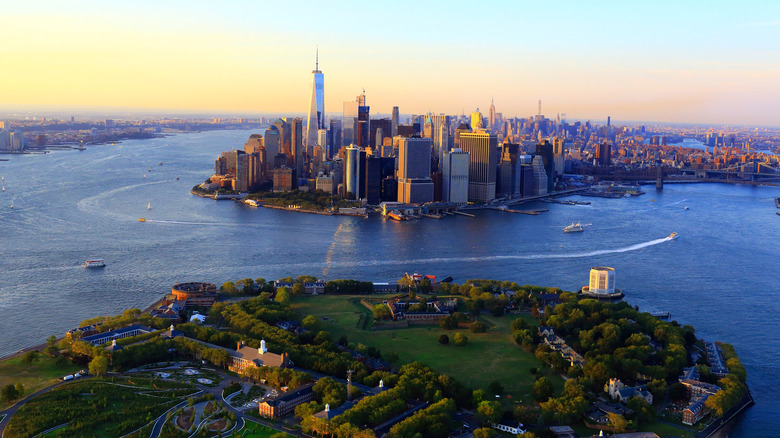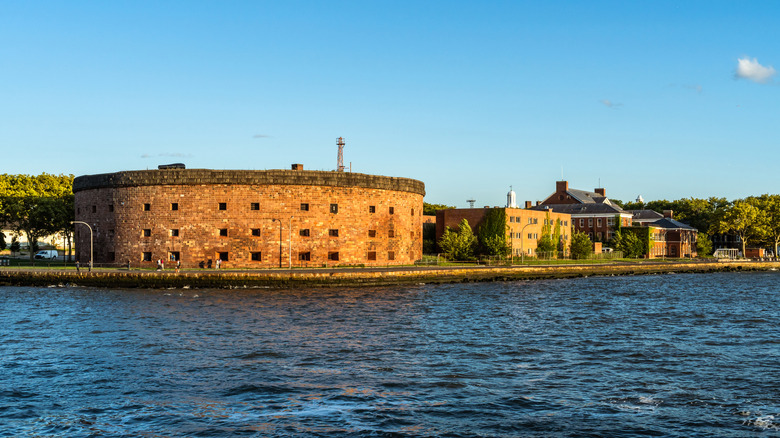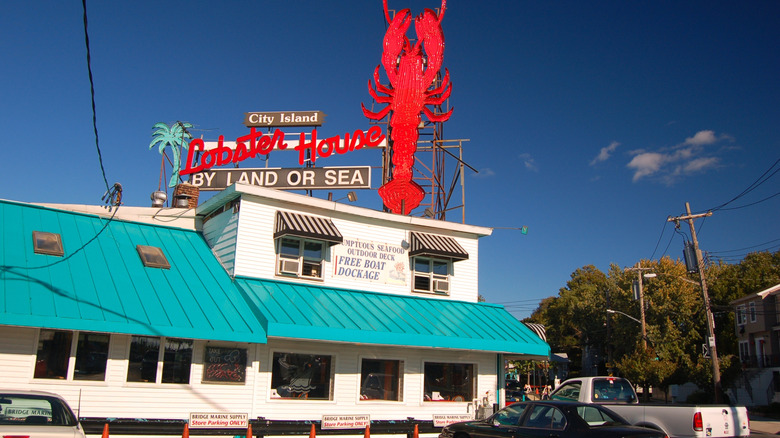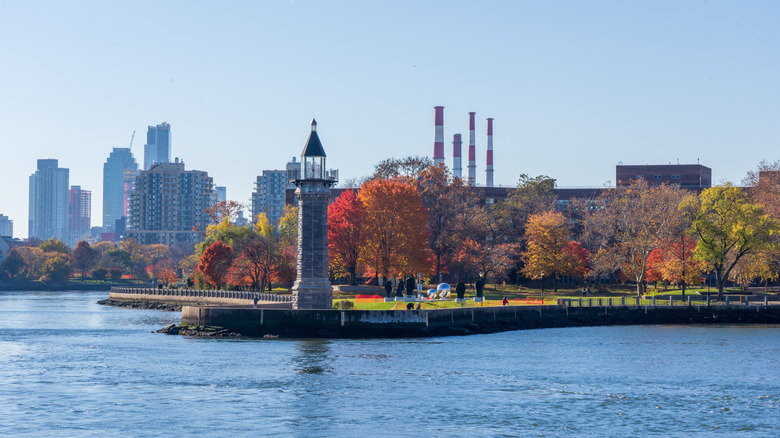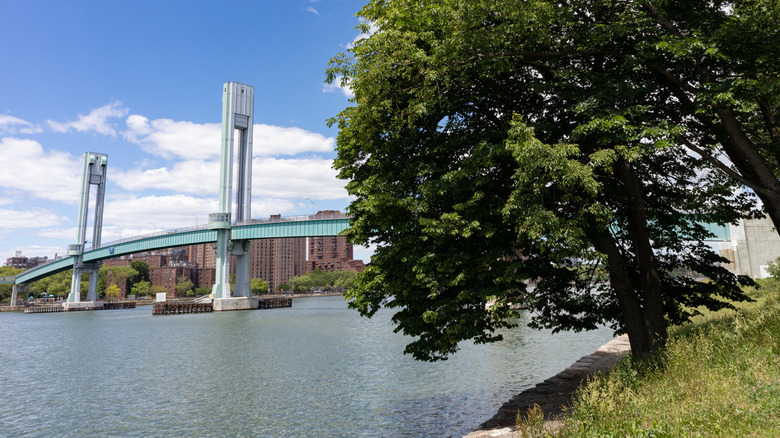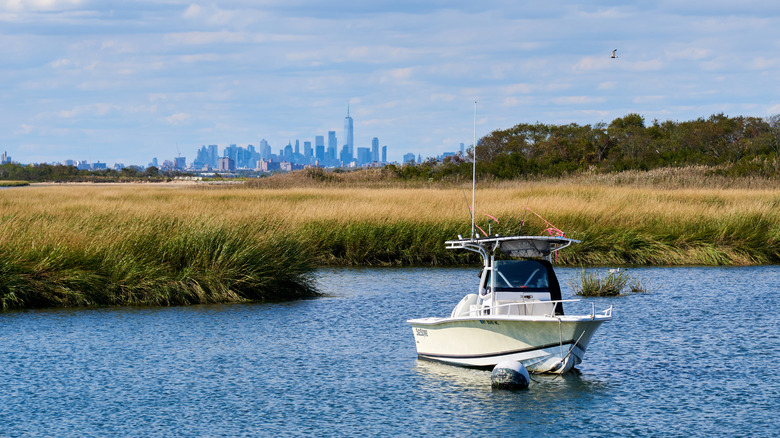Escape The Hustle Of New York City For The Serene Beauty Of Its Hidden Islands
While New York City is best known for its skyline, subway, and iconic spots from your favorite movies, it's also an archipelago, comprising over 30 islands. You might first think of its two bustling borough islands: Manhattan and Staten Island. But what about the island with no cars and a hill made from construction debris? Or the one with a lighthouse, an abandoned smallpox hospital, and a grassy riverside park with views of the Manhattan skyline? The smaller islands spread throughout NYC's waterways hold secrets that most visitors (and even locals) don't ever discover.
Over the centuries, the islands of New York have served all sorts of purposes, such as military outposts, fishing villages, naval ports, and even mental asylums. Some seem frozen in time, with vine-covered ruins and rusted stairwells. But many have been reinvented as parks, art spaces, or quieter neighborhoods that can feel a world away from the city grind without ever leaving the city itself. Whether you're a local looking to clear your head or a traveler hoping to see a different side of the city, these five islands are fascinating places to escape from the throngs of tourists and jostling suits and ties. Some are steeped in history, others in nature. All are surprisingly easy to reach, often just a ferry (or sky tram) ride away.
Bike around military ruins on Governors Island
You might know about Governors Island for an element of its recent history: It was the original site of the Governors Ball music festival. Long before the stages were put up, though, it was patrolled by Continental soldiers slinging muskets and mounted with cannons as a military post during the Revolutionary War. Following the war, New York fortified the island, building Fort Jay here in 1796. About a decade later, another fort called Castle Williams was established. You can visit both of these historic structures today. Castle Williams is only open for guided tours, while Fort Jay is open to visitors seasonally.
Another unique experience you can have on Governors Island is glamping with skyline views. Collective Retreats has a few different options for visitors looking to spend a night on the island, from luxury villas to furnished tents, all surrounded by green space that makes it feel like you're far from the city (though you can see the skyscrapers of Lower Manhattan out the window). You don't need to rent out a glamping lodge to get the views, though — just climb up one of the grassy overlooks aptly called "the Hills," which were artificially made from demolition debris, and look out to the Statue of Liberty and Manhattan's skyline.
Governors Island is designed for cycling. It has seven miles of bike paths (that get all the views, too), and it's totally car-free. You can either bring your own bike on the ferry or rent a Citibike (one of the cheapest ways to navigate around New York City) after arriving. The island is only accessible by ferry, but luckily, it's very affordable and has stops all along the Brooklyn waterfront and Lower Manhattan, running from morning into the evening.
Eat your way through a seaside village on City Island
Called the "Nantucket of the Bronx" by Curbed, City Island is a walkable neighborhood that has been a hub of maritime activity since the 19th century. At one time, the island was a shipbuilding and yachting center. Walking around the island, you can see this legacy reflected in yacht clubs, marinas, and sailing schools. Dive into this history (no pun intended) at the free City Island Nautical Museum, where they have model boats and ship sails.
It's easy to say that what defines the island's culture today is its seafood — you'll find a seafood restaurant on almost every block, serving fish and lobster from local catches. In a roundup of seafood restaurants on the island, Westchester Blogger named Johnny's Reef "one of the island's best places for fried shrimp." The restaurant also looks right out onto the water. For something with a bit of interesting history, head to the Original Crab Shanty, which is housed in a former silent movie theater from the early 20th century. The New York Daily News spotlighted the restaurant as one of its "NYC hidden dining gems."
If you're driving, you can get to City Island in about 30 to 40 minutes from Midtown Manhattan by crossing the City Island Bridge. By public transit, you can take the 6 train to Pelham Bay Park, then transfer to the Bx29 bus, which takes you right onto the island.
Stroll through the past on Roosevelt Island
A scenic tramway ride from Manhattan will take you to the quiet Roosevelt Island. The Roosevelt Island Tramway is itself a New York highlight, connecting the island to Midtown East over the East River, payable with a MetroCard. Once there, you can easily walk around the whole island in a bit over an hour, or you could take the free Roosevelt Island Red Bus to get around (and maybe discover some interesting sights along the way).
On either end of the narrow island are two unique historical structures that serve as excellent bookends for a day trip. The south tip has the Gothic-style ruins of a smallpox hospital from the mid-1800s. While entering the ruins is off-limits (for now), you can walk around them in Southpoint Park. The park is also home to the Roosevelt Island Cat Sanctuary.
Walk north along the riverside pathway, and you'll eventually get to the island's other historic — and equally eerie — structure, The Octagon. It was once the center of the New York Lunatic Asylum, where, infamously, journalist Nellie Bly went undercover in the late 1800s as a patient to expose the harsh treatment of people with mental illness. Keep heading north past The Octagon, and you'll get to Lighthouse Park, one of the most picturesque spots in the city. It's home to a 19th-century lighthouse and a modern art installation consisting of five giant bronze faces.
Smell the flowers on Randalls and Wards Islands
If there's one reason to visit the conjoined Randalls and Wards Islands, it's the multiple native plant gardens tucked between bridges and with passing trains overhead (something you won't find anywhere else in New York City). There's the Hell Gate Wildflower Meadow, which has views of the turbulent Hell Gate rapids and paths through native perennials. At the Freshwater Meadow, connecting to the island's salt marsh, you'll see butterflies pollinating wildflowers among tall grass. Meanwhile, the White Garden, on the island's southern point, brings together a variety of white flowers with a birch grove. You can stroll through these gardens for free and get a sense for Randalls and Wards Islands' thriving ecosystems.
The mix of green space and waterfront views is what makes the island ideal for taking in nature and finding a spot to picnic. Make an itinerary to see the island's best spots by starting in the foodie neighborhood of Astoria, Queens, then heading west and up to the Hell's Gate Salt Marsh. Reddit user rvlnyc says, "The nicest portion spans from the area directly across from Astoria park, then south and up the west side of the island to Icahn Stadium (all along the River)." Coming in from or going to Manhattan by foot, you'll definitely want to walk along the Wards Island Bridge. It's reserved for pedestrians and cyclists and offers great views across the river. Other than walking or biking, you can reach the island by the M35 bus from the corner of Lexington Avenue and 125th Street in Manhattan. By car, it's about a roughly 20-minute drive from Midtown, going over the RFK Bridge directly onto the island.
Go bird watching at Broad Channel
In the estuary of Jamaica Bay, Queens, there's one island called New York City's "most isolated neighborhood" by Columbia Spectator. Broad Channel is the only inhabited island in the bay — though, to be fair, most of it is a wildlife refuge. The small neighborhood of Broad Channel doesn't see many visitors, but that's what fosters the "nice homey feel about it," New York travel blogger mywalkinmanhattan explains. Despite its isolation, the island is pretty easy to get to (even though local migrating turtles did once contribute to one of the most bizarre flight delays at nearby JFK Airport). The region is connected to the city's A train via the Broad Channel subway station. Drivers can access the island by bridge; it'll take about an hour from Midtown.
Homes on stilts, canals, and fishing boats moored in the bays give you an understanding of how the neighborhood earned the nickname Venice of New York. Most of the neighborhood is residential, though you'll find a few pizzerias, bars, and restaurants around. Adrienne's NYC is a standout, called a "hidden gem on the water" by one TripAdvisor reviewer.
But the main draw of Broad Channel is its nature. On the southern side of the island is Broad Channel American Park, featuring a public beach and sports courts. The northern part of the island is the Jamaica Bay Wildlife Refuge. It's made up of a variety of habitats, from woods to wetlands, with hiking trails and lookout benches dotted along the water. The refuge is particularly known for its birds: Over 300 different species have been spotted here, with egrets, herons, and oystercatchers being regular nesters.
